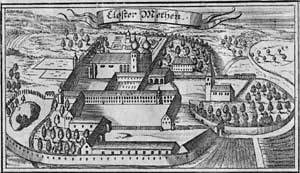
The Abbey of Saint Victor, Paris, also known as Royal Abbey and School of Saint Victor, was an abbey near Paris, France. Its origins are connected to the decision of William of Champeaux, the Archdeacon of Paris, to retire to a small hermitage near Paris in 1108. He took on the life, vocation and observances of the Canons Regular, and his new community followed the Augustinian Rule.
Contents
- Formation
- Makeup of the Congregation
- Library
- Scriptorium
- Masters of Saint-Victor
- Burials at the Abbey
- References
- Further reading
- External links
William was famed for his teaching, and was followed to his hermitage by many of his disciples, including Peter Abelard, and was convinced by them to take up his lecturing again. William was made Bishop of Châlons-sur-Marne in 1113, and was succeeded in his hermitage at St. Victor's by Gilduin, who promoted the canonical order and its new abbey vigorously.
Through generous gifts from popes, kings, queens, and nobles, the Abbey of St. Victor was soon richly endowed. Many houses of canons regular came under its influence and were reformed through its leadership, including the Abbey of Ste Geneviève (Paris), Wigmore Abbey in Herefordshire, St. Augustine's (Bristol), St. Catherine's (Waterford), St. Thomas's (Dublin), and San Pietro ad Aram (Naples). [1] King Louis VIII mentioned no less than forty abbeys of the Order of St. Victor in his last will and testament, and he left 4,000 pounds to be equally divided among them, and all his jewels for the building of the abbey church in Paris. Before the abbey was 160 years old, several cardinals and at least eight significant abbots had been produced from among its members.

The traditions of William of Champeaux were handed on, and the abbey became a center of piety and learning, attracting famous students, scholars and intellectuals including Hugh of St. Victor, Peter Lombard and Thomas Becket. In fact, the school of Saint Victor, with the schools of Ste Geneviève and Notre-Dame de Paris, was the cradle of the University of Paris.












